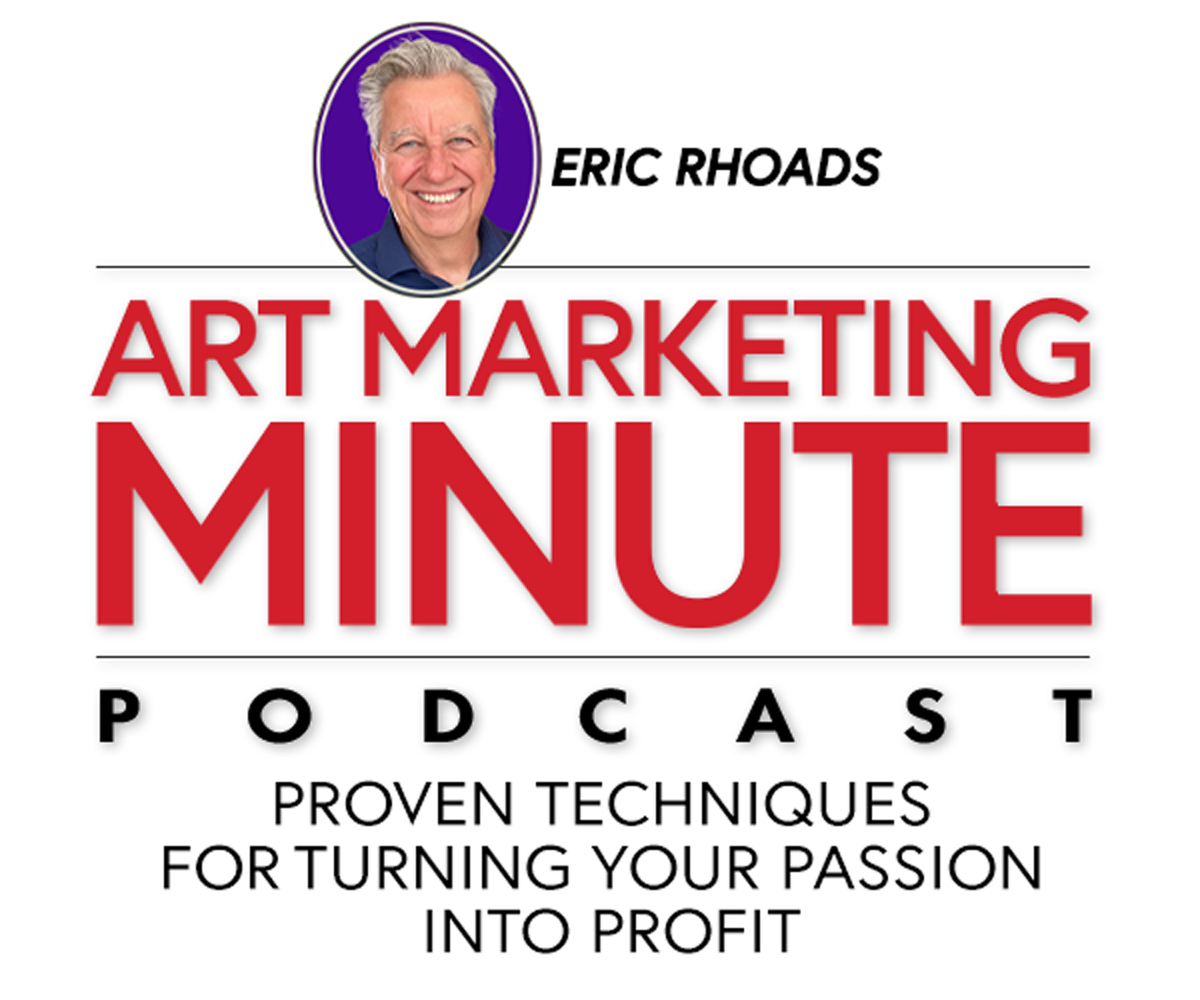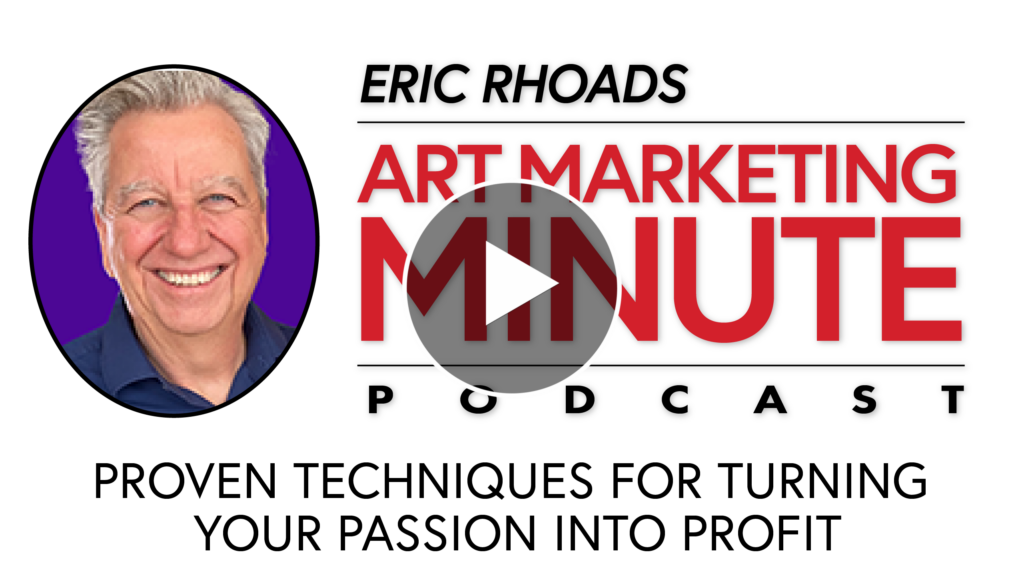When someone buys your painting, should they sign a contract about reproduction rights? How do you finalize a sale when someone is contemplating a purchase (including one question you should ask)? Eric Rhoads answers in this week’s Art Marketing Minute Podcast.
In the Art Marketing Minute Podcast, you’ll learn how to sell your art, how to market your paintings, and everything else you need to know in order to have a successful art career. Each episode answers questions from artists by host Eric Rhoads, author of “Make More Money Selling Your Art,” publisher of several art magazines and newsletters, and author of ArtMarketing.com.
Listen to the Art Marketing Minute Podcast: Episode 80 >
Submit Your Art Marketing Question:
What questions do you have about selling your art? Email Eric today at [email protected] (include your name and where you’re from) to hear your question answered on an upcoming Art Marketing Minute Podcast.
FULL TRANSCRIPT of the Art Marketing Minute:
DISCLAIMER: The following is the output of a transcription from an audio recording of the Art Marketing Minute. Although the transcription is mostly correct, in some cases it is slightly inaccurate due to the recording and/or software transcription.
Announcer:
This is the Art Marketing Minute with Eric Rhoads, author of the Amazon best selling book, “Make More Money Selling Your Art.” In the marketing minute we answer your questions to help your art career brought to you by artmarketing.com, the place to go to learn more about marketing. Now, here’s your host, arts magazine publisher, Eric Rhoads.
Eric Rhoads:
In the marketing minute I answer your art marketing questions. You can email them to me [email protected]. A question from Tom. And from Rozendaal arts. He says I’m Dutch currently living in Pisa Italy. I’m working towards selling my first original works and was wondering if I should make some sort of a buyer’s contract that states the buyer is not allowed to reproduce the work etc. Thanks in advance.
Tom, thanks for that. Question Hello in Italy and I hope you’re safe and healthy. One day I’ll get over there to paint the leaning tower with you. How about we do that? Anyway. I don’t know the law in Europe. I don’t even know the law here. But I do know a lot about copyright law. We do a lot of copywriting around here. Copy right around here. copywriting is writing copy. That’s a different thing. Anyway, I don’t want to scare anybody off as a buyer and I’m not so sure making them sign a contract. You might have a bill of sale that it might By the way, it has a little statement about this just says that you own the artwork, it’s your copyright and they cannot reproduce it. What I tend to like to do is I put on the back anyway, I put a circle “c” Copyright 2020 my name, comma in capital, all rights reserved. All rights are all rights. Sometimes, I’ll put a statement on the back of the painting too that says that The artist holds the copyright to this painting and does not. And the buyer does not receive rights for reproduction. So you could you could have a lawyer or somebody come up with a statement, I’m sure you could come up with something like that. That’s not going to spook anybody. Most people aren’t going to do it anyway. But you just want to have a little protection there. A copyright technically is your protection. We have a podcast on copyrights that we did a couple of months ago and you might want to look for that it might be worth listening to.
Next question is from Alex in Washington State who says I’m an artist in a high end, collective gallery in Seattle. I do a good job selling my work for the most part, but occasionally I find I lose a sale awkwardly at the end. Here’s my routine. I wait for the customer to stop and spend time with a painting. I come up casually I chat with them and I inquire as to what they like about the work. I use their answer to talk about the art and then tell them any story that is attached to creating that piece outdoors and why I feel my work is important at this moment in time. And what I hope it will represent in the future of our region. At this point, they either say I’ll take it or there’s an awkward long pause before saying thank you and moving on to the next. before they leave, I give them my card say thanks for visiting the gallery and I inform them in the next opening or any event that will be bringing them back. I also post that painting on Instagram or Facebook several times, in hopes they’re gonna see it. Sometimes they do come back sometimes they say they can’t stop thinking about it, than the story behind it. And they buy it most of the time. They’re just gone. And that’s it. The question I have is, how do I ask for the sale at That awkward moment when I know they’re anticipating a pitch or contemplating a sale with me? I have flat out asked do you want me to wrap that up for you but that has met with hard nosed Most of the time, and they will not return to the painting after looking at others. So I if I try a hard sale, I’m afraid that’s going to blow it.
Alex, you’re doing most everything right. You want to ask a question and engaging question. Rather than what do you like about that work, which might put somebody off? You might say, does that painting remind you of something? Because most people see a painting and they go, Oh, that reminds me of my childhood or a place I grew up. I have a painting in my sister in law’s house. And everybody says, Oh, I know exactly where that is. That reminds me of when I was a kid, you know, it’s a swing hanging from a tree. And so people are reminded things, ask a question, and then shut up and let them talk. Try to keep them talking with statements like really tell me more, but don’t be too obvious or certainly not manipulative about it. You can then say, by the way, I’m the artist. If you have any questions, I’m nearby. And if they have a question they’ll ask right then They probably don’t want to be pressured though nobody wants to be pressured. The key to selling is paying close attention to the reactions and the body language. If their arms are crossed, they don’t want to talk to you, my guess is that you might be going into more detail. You talked about how you’re talking about, you know, the future of your artwork and all that stuff, you might just be boring them to death. You know, the key is, say something, let them talk. Let them talk, right. There are lots of books on selling in the market. Most of them especially the older ones are manipulative and old school. It can’t hurt to read them. But quite frankly, if they can afford a painting, they probably heard all these trial closes and all that old nonsense. I don’t like it anymore. Anyway. If you’re not going to sell somebody you’re not going to sell. You’re not going to get everybody. Most importantly, give them an image of the painting and say, if you can’t stop thinking about it, let me know, I’ve put my mobile number on it and be happy to deliver it and hang it up for you. Or you might try something else. Like you could say, hey, do you mind if I get somebody to take my picture with you guys in the painting, take it off the wall, put it in their hands, get the picture. And then say, let me email that to you. And by the way, if you’re interested in it, you know, I’ll bring it over and hang it up for you. And don’t mention the price. If they don’t mention the price. They’ll if they ask the price, that is an indicator that there is some interest. But some people ask the price because they’ve got a number in their head. And the your number is different from their number and they’ve already decided, oh, boy, I don’t know that’s a little bit too much. The other thing is sometimes there’s a technique that’s used in retail, where they try to get a number, a higher number, and then they have a lower number and people remember the higher number and think its that value and then you bring them to the lower number. That’s a little more that I want to get into today because it’s kind of, I don’t know, maybe manipulative, so I don’t want to be manipulative. anyway. Most important is just chat with them strike up a conversation. Don’t be, you know, people can sense your angst over selling a painting. Don’t oversell them, just talk to them and say, Hey, you know, Thanks for looking at my painting, I’m really honored that you looked at it, and I hope you liked it. And, you know, then Nice meeting you and where you guys from and what are you into and you know, just let them talk, the more they talk, the more they’re going to like you maybe, hopefully, and then the more they talk, the more they might before they walk out say hey, by the way, where, you know, how much is this painting? And that’s when you say, Well, you know, today it’s this amount of money because, quite frankly, you know, whatever. you know, I’ve discounted it or I’m not discounted it or it’s you know, whatever the price is you just kinda have to play that out. The other thing is a trick that I use Oftentimes when I’m consulting galleries, and this is a trick that’s used. I don’t like the word trick, but it’s a technique that’s used in the retail business that came from the jewelry business, they’ll put a price on a ring under a spotlight in a glass case, and they’ll make it three times exactly three times the ideal price they’re trying to get. Well, the thing you can do, for instance, is you can hang it, let’s say it’s a $2,000 painting you’re trying to sell. You have a $6,000 painting hanging on the wall, clearly a visible $6,000 price. And then next to it, you have three or four or five $2,000 paintings. And so the $2,000 paintings feel a little bit more attainable and yet you are perceived as a $6,000. artist, right? So that’s one thing that can be done. You might want to try that anyway, it’s you’ll see it you’ll notice it once you start going into galleries because they do that All the time. Lots of them do. Anyway. hope that’s helpful.
Well, this has been the art marketing minute with me. Eric Rhoads. My goal in life is to eliminate the idea of the starving artist to help your dreams actually come true. So if you want to submit questions, simply email [email protected]. And to learn more about marketing ideas, you can visit Artmarketing.com. Thanks for listening.
How to Submit Your Art Marketing Questions: What questions do you have about selling your art? Email Eric today at [email protected] (include your name and where you’re from) to hear your question answered on an upcoming Art Marketing Minute Podcast.



Leave A Comment